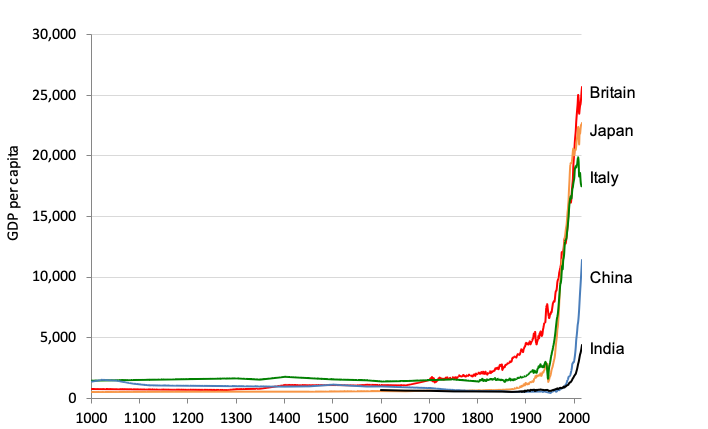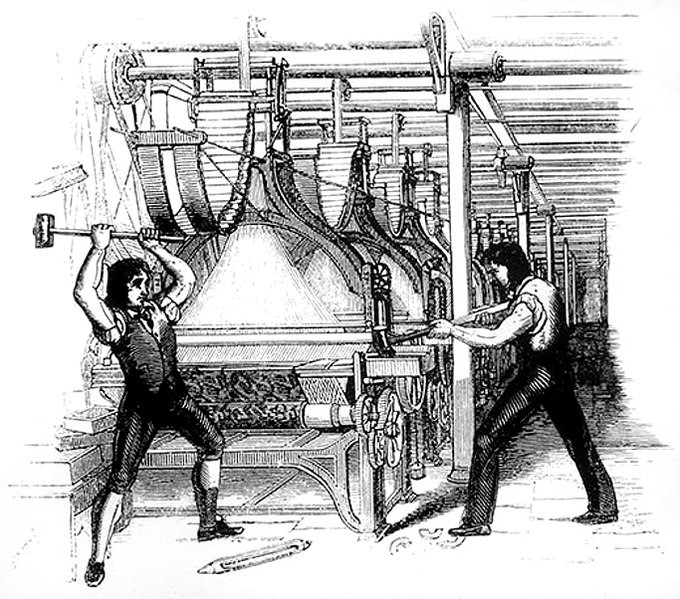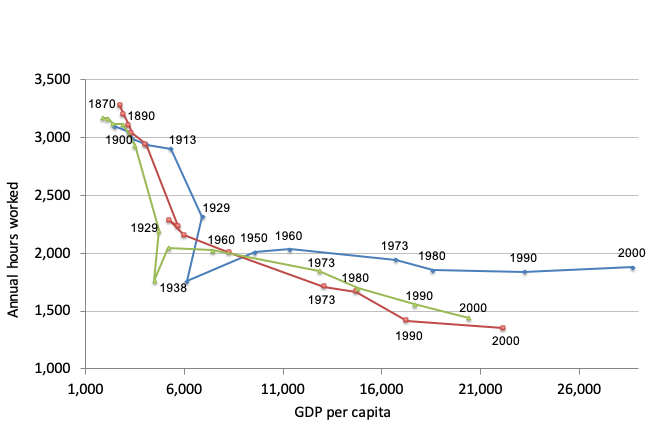One of the most spectacular facts of the last two centuries of economic history is the exponential growth in GDP per capita in most of the world. Figure 1 shows the rise (and the difference) in living standards for five countries since 1000 AD.

This economic progress, unprecedented in human history, would be impossible without major breakthroughs in technology. The economic historian Joel Mokyr has argued that the Enlightenment in Britain brought new ways to transfer scientific discoveries into practical tools for engineers and artisans. The steam engine, electricity, sanitation are examples of technological discoveries that propelled the engine of economic growth, increasing standards of living across the planet.
At the outset of the Industrial Revolution, the Luddite movement rose out of fear of labor displacement in the British textile sector. Famously, the Luddite protesters destroyed the very machines they were using at work, in order to preserve their role as active members of society. Their reasoning was that if automation could double, triple, or quadruple a worker’s output, the economy would need half, a third, a quarter of the current workforce. The Luddite movement was eventually suppressed by military force in 1816, but history has proven them partly correct.

Humans do work shorter hours today than in the 19th century, as shown in Figure 3.

Many Silicon Valley executives like the Tesla CEO Elon Musk believe that we are on the verge of a new technological revolution that will see Artificial Intelligence (AI) automating a majority of tasks that are currently performed by humans. Just as horses were displaced by motor vehicles, truck drivers may soon be replaced by self-driving vehicles.
Factories producing components for personal computers and tablets are also becoming highly automated. The BBC reports (May 25, 2016) that FoxConn has replaced 60,000 of its workers with robots. A January 2016 Oxford University study claims that 47% of US jobs could be lost to automation, along with 69% of jobs in India, 77% in China, and 57% worldwide. Machine learning enables robots to make decisions based on a vast amount of data on (sometimes very difficult) decision-making by highly-skilled humans.
Should we then fear that the forthcoming AI Revolution will force humanity to completely rethink the current organization of our lives?
One of the most important economic thinkers of all time, John Maynard Keynes, wrote in his 1930 essay “The Economic Possibilities for our Grandchildren” that by the 21st century we could fulfill our needs and wants with a 15 hours workweek and devote the rest of our lives to non-monetary pursuits. Fast-forward to 2014, when the late physicist Stephen Hawking told the BBC that “artificial intelligence could spell the end of the human race.”
Should we see AI as liberating or as a destructive force?
Economists have debated the effect of technology and automation on jobs for a long time. The first set of questions regards labor displacement and whether there is any future for work at all. The second set of questions has to do with how automation impacts income and wealth inequality. On the one hand, if the ownership of robots is concentrated in the hands of a few—let’s call them the 1%—and a majority of jobs disappears for the 99%, it will exacerbate inequality, which is already on the rise (see Figure 4). On the other hand, technological change is also creating polarization in the labor market among the 99%. According to the MIT economist David Autor, between 1989 and 2007 job creation has occurred mostly in low-paying and high-paying jobs, while middle-class jobs were affected by job destruction on net.

It is true that automation displaces workers in some sectors, but workers reallocate to other sectors over time. Historical examples in advanced economies like the US are the transition from rural agriculture to urban manufacturing during the first half of the 20th century, and from manufacturing to services in more recent times.
The net effect on jobs does not seem to lend support to Hawking and Musk’s gloomy predictions. This is even more true if one considers another beneficial effect of technological change: everyday objects like dishwashers, vacuum cleaners, washers, and dryers, reduced the burden of housekeeping and freed up time for women to seek employment. Indeed, the labor force participation rate was 67% in 2000, compared to 59% in 1948. The increases in labor productivity brought about by technological change spill over into higher wages for workers: in a 2015 report, Economic Policy Institute economists Josh Bivens and Larry Mishel have documented that the average hourly compensation for the typical American worker in 2014 grew by about 110% relative to 1948.
This is not to say that technological change has no costs for society. The transition from agriculture to manufacturing took time, and in the short run produced economic anxiety, unemployment, and poverty among former agricultural workers. The same applies to the transition to a service economy, although there are some troubling peculiarities about the latter process. The transition to manufacturing was associated with higher wages and employment protection through union membership. The transition to services not so much: low-skill service workers tend to be paid less than workers of similar skills in manufacturing, and service workers are in general not unionized: consequently, they do not take advantage of the benefits of collective bargaining in terms of wages.
Another cause of concern is that automation and technological change is characterized by increasing returns: doubling the scale of production enables production at more than twice the output at the initial scale. Increasing returns lower the cost of production as the scale of a firm expands, which leads to firm concentration toward few, large firms with lots of market power. And it is not by chance that the most visible hi-tech industries, such as Apple, Amazon, Google, and Microsoft are all basically monopolies.
The decline of manufacturing employment and the increasing concentration of the US corporate sector are two reasons why average wages have not kept up with the increase in labor productivity over the last 40 years. An average 2015 worker is almost 2.4 times more productive than an average 1948 worker, but her wage is only 110% higher. Wages were growing on par with labor productivity up to the 1970s; starting in the 1980s, productivity has been growing at a much faster pace. The process of job polarization has fed into this pattern, determining rising employment in low-paying sectors and high-paying sectors, at the expense of good middle-class jobs.
Although it is possible that AI is completely different from the technological advances of the past, we should be skeptical that automation will mean the end of work. Jobs—or even specific tasks—will be displaced, but workers will relocate to different jobs or take up different tasks. For low- and medium-skill workers, it is likely that the relocation will occur in jobs of lower quality, meaning either lower pay, or fewer benefits, or a combination of both. Workers who possess skills that are complementary to new technologies, on the other hand, will benefit from the advent of automation by reaping most of the productivity increases in the form of higher wages. And the very few CEOs of successful tech companies will see their incomes skyrocket.
Hence, citizens and policymakers concerned with the rise of automation should focus on its effects on inequality. During the 1980s economists have embraced supply-side views that inequality is beneficial for growth, but recent academic research has shown that the opposite is true. The work by economists Thomas Piketty, Emmanuel Saez, and Gabriel Zucman has suggested that high marginal tax rates on top incomes—that is, tax rates levied on every dollar earned above a certain, typically very high threshold—would go a long way in reducing inequality without distorting the individual incentives to work hard. Indeed, the US economy grew fastest between 1950 and 1970, when the top marginal tax rate was well above 70%. The corresponding tax revenues could be used to provide unemployment compensation or foster the provision of public goods such as education and training for workers to relocate when their jobs are automated.
